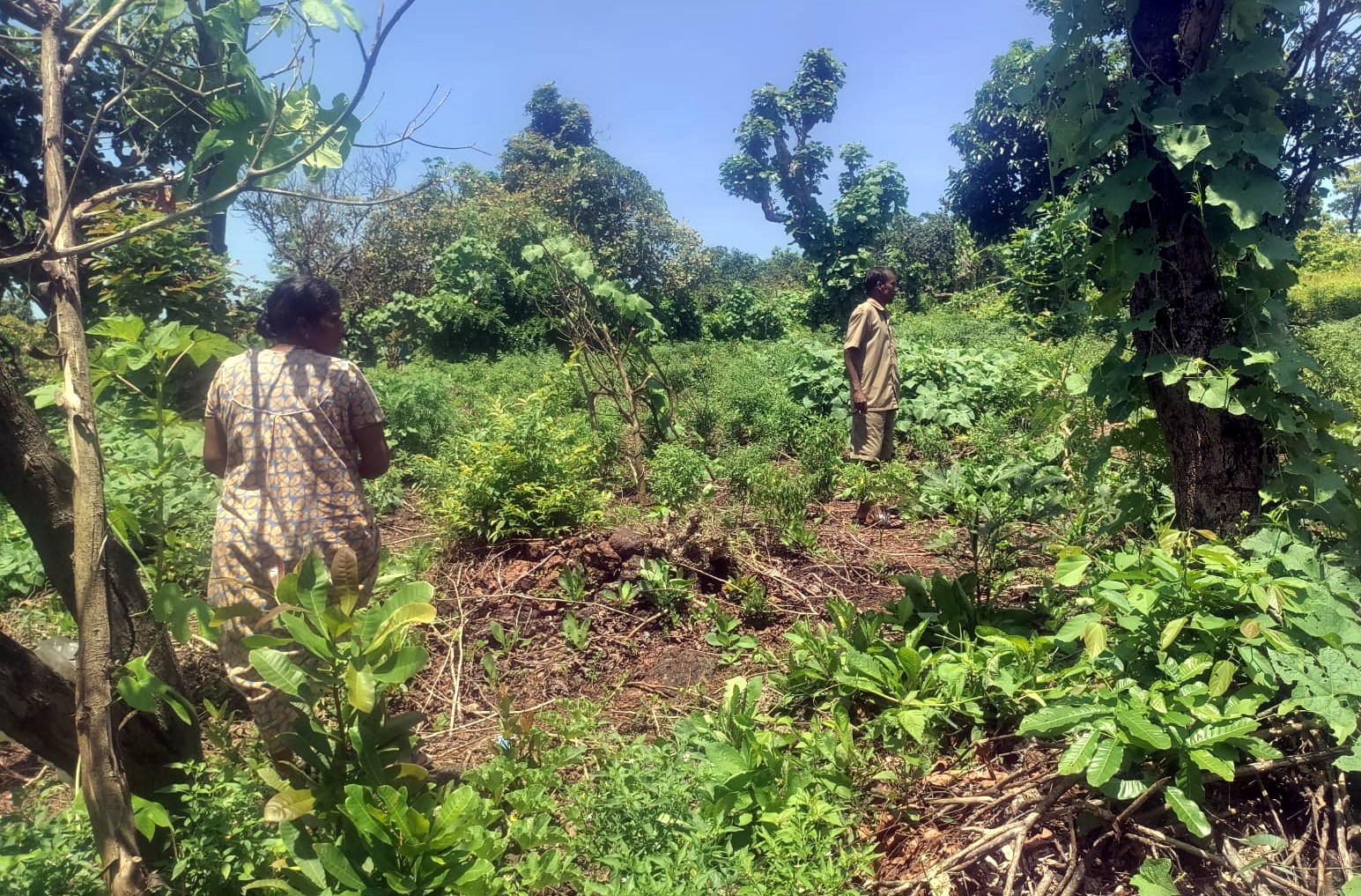Cultivators unhappy chillies from other regions projected, sold as Khola chillies

One of the Khola Chilli cultivators Shrikant Velip and his wife at their plantation in Khola.
CANACONA
The recent recognition to the popular Khola Chilli as Goa’s first Farmer Plant Variety (FPV) has added further distinction to the acclaimed chillies.
While chilli cultivators from Khola are delighted that this recognition will give a further boost to their unique produce, they are unhappy that imitations of their famed Khola chillies springing up in other regions.
The Khola-Canacona Chilli Cultivators Group (K-CCCG) was registered in 2016 and the present executive committee comprises Ratnakar Velip (president), Suvida Zaravkar (secretary) and Radha Talpikar (treasurer).
According to Ratnakar Velip, the K-CCCG comprises 25 different groups, including Self-Help Groups, operating in and around Khola.
“There are an estimated 1,000 families cultivating chillies in the hilly regions of Khola and surrounding villages of Barcem-Quedem and Padi villages,” said Velip.
“Each family on an average cultivates an area of about 500-1,000 sq mtrs, producing anywhere between 30-50 kgs of Khola chillies. The chilli production in a season is approximately between 30-50 tonnes.”
Ratnakar Velip said the process of cultivating Khola chillies begins in May.
"The chilli nursery begins in paddy fields and 20-25 days into the monsoon rains, chilli saplings are transplanted in forest/hilly terrains along with other seasonal vegetable cultivations," said Velip.
Velip insisted that no chemical fertiliser is used in the cultivation of Khola chillies.
"Only local manure for plants and chopped-up leaves are used as organic manure," he said.
THE VARIETY
The Khola chilli is a distinctive variety traditionally cultivated by the tribal communities of Khola village in a traditional farming system.
This chilli, renowned for its vibrant red colour and moderate pungency, is believed to be rich in potassium, manganese and magnesium, and is used in curries, pickles and in other dishes.
Ratnakar Velip explained that chillies cultivated and grown in the hilly terrains of Khola and surroundings gets its distinct flavour due to the type of soil that these terrains offer during the cultivation.
"Even if people take Khola chilli seeds, raise a nursery and cultivate them in places other than the Khola hills, the produce and flavour will never be the same as the Khola chilli," said Velip.
THE RECOGNITION
The Khola chillies have been recognised at the national level, not only for its distinct variety but also for the process of conservation and preservation through traditional ways.
In 2017-18, Khola chilli cultivators had won a central award for conservation and preservation of the local Khola variety of chillies through traditional ways. A cheque for Rs 10 lakh was presented to the K-CCCG committee.
In September 2018, the Protection of Plant Varieties and Farmers' Rights Authority (PPV-FRA) of the Ministry of Agriculture and Farmers' Welfare, New Delhi had presented the Plant Genome Saviour Community Award to the K-CCCG.
In 2020, the Geographical Indication (GI) tag was granted to the Khola chilli, as an intellectual property right to help preserve the originality of a product from a specific region.
Recently, the PPV&FRA of the central government officially declared Khola Chilli as a Farmer Plant Variety, making it the first Farmer Plant Variety from Goa registered with the Plant Varieties Registry of PPV&FRA.
As such, the K-CCCG has been officially recognised as the true breeder of this unique variety and the group now holds exclusive rights to produce, sell, market, distribute, import, and export the variety for an initial period of six years and renewable up to 2039.
THE BENEFITS
K-CCCG President Ratnakar Velip admitted that the GI tag for the Khola chilli has not only helped the chillies become world-famous, it has boosted the demand for the chillies.
"Following the grant of the GI tag, Khola chillies are in huge demand and rates have soared from earlier Rs 400-500 per kg to Rs 1,200-1,500 per kg. Sometimes, merchants sell the Khola chillies for as high as Rs 2,000 a kg," said Velip. "On the other hand, black marketeers have now begun to sell other varieties of chilli as Khola chillies."
Asked if Khola chilli cultivators get subsidies from the government, Velip replied: "We get no subsidies, but we were given a weighing and packaging machine from the government."
THE CHALLENGES
Velip admitted that while Khola chillies yield a high return on account of its acclaimed status, there are a number of challenges to produce and market Khola chillies. "The plots require to be protected from wild animals, particularly from monkeys, wild boars and bison," said Velip.
“Cultivators also have to worry about natural calamities like rains and cyclones which can severely damage their crops.”
Another cultivator Shrikant Velip said, “Since the start of the plantation, normally in the fourth week of June, the cultivation has to be protected day and night from wild animals and birds, till we complete our last cultivation of Khola chillies,” he said.
Both Khola Sarpanch Priyanka Pavitra Velip and K-CCCG President Ratnakar Velip were unhappy that famed Khola chillies have led to imitations from other regions.
"Chilli cultivators from other places tend to sell their produce as ‘Khola Chilli’, and this is clearly cheating unsuspecting customers unaware that those are not Khola chillies,” said Ratnakar.
Added Priyanka Velip: “It is an honour for Khola cultivators to be given the exclusive right to cultivate and market Khola chillies. However, it is sad that chilli cultivators from other places are now projecting and selling their chillies as ‘Khola Mirsang’, which is very wrong.”